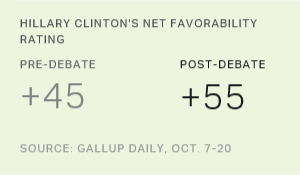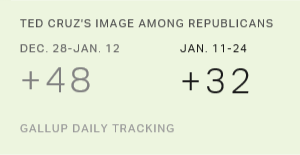Story Highlights
- Carson's net favorable score of +60 tops GOP field
- Carson's unfavorable rating low compared with Trump, Bush, Christie
- Republicans' views of most candidates stable
PRINCETON, N.J. -- Republicans preparing to watch Wednesday night's GOP debate have varying opinions of the candidates vying for their party's nomination. The candidates' net favorable scores range from +60 for Ben Carson to +8 for John Kasich and +10 for Chris Christie. Carson's strength of image is formidable; his net favorable score -- the difference between his favorable and unfavorable ratings -- is 20 percentage points higher than the next-highest-rated candidate, Marco Rubio. Donald Trump and Jeb Bush both have relatively high unfavorable ratings, pushing their net favorable scores well below those of several other candidates.

Carly Fiorina has the third-highest net favorable rating of the nine Republicans Â鶹´«Ã½AV is now tracking, at +33, followed by Mike Huckabee, Ted Cruz and Trump. Bush, whose familiarity among Republicans is second only to Trump's, has a net favorable score of +19, above only Christie and Kasich.
Carson's big lead on the measure of net favorability is based on his 68% favorable rating, the highest of any candidate, and his 8% unfavorable rating, which is the lowest.
The upcoming debate at the University of Colorado in Boulder is the third time Republicans will face off this election cycle, following those held on Aug. 6 and Sept. 16. Â鶹´«Ã½AV's candidate image ratings are based on interviews conducted Oct. 13-26 with approximately 800 to 900 Republicans and Republican-leaning independents evaluating each candidate.
Carson and Fiorina Have Benefited Most From Debates
Debates can make at least some difference in the way Republicans view candidates, and the elapsed time since the first debate in early August has been particularly positive for Carson and Fiorina. Just prior to the first debate, Carson's net favorable score was essentially tied with Rubio's, with Fiorina near the bottom of the list. By the eve of the second debate, both Carson's and Fiorina's images had improved significantly, and have stayed the same or edged up further in the time since. Christie's image has also improved, but given his starting point at -2 prior to the first debate, his current +10 net favorable score places him just above Kasich at the bottom of the list.
Notably, Kasich and Bush are the only candidates whose images are worse now than just prior to the first debate, although Bush's current +19 is an improvement over the depths to which he fell just before the second debate. Kasich's image did rise shortly after the first debate, but then fell back again and has remained low since.
Net favorable scores for Rubio, Cruz and Huckabee have not changed much over time.

Republicans' views of Trump have varied over the last three months. Although his current net favorable score is higher than it was prior to the first debate in early August, Â鶹´«Ã½AV's two-week rolling averages show considerable change. His net favorable score rose going into the second debate in September and fell after the debate, but has now returned to where it was.

What the Data Mean for the Debate
Carson's "softer" presentation of self in previous debates has worked well for the former neurosurgeon among the GOP faithful, and he goes into the debate Wednesday with high positive ratings and low negative ratings. His main challenge will be to convince future GOP primary voters that he has issue positions and capabilities that would make him a viable choice for their party's nomination.
The debate will be critical for Bush, who to date has not been able to parlay his high name recognition into a strongly positive image among Republicans. A glimmer of good news comes from the trend on his image, which is now a bit more positive than it was just prior to the second debate -- but the former Florida governor has a challenging road ahead as he tries to improve his image among Republicans.
Trump will be the most polarizing candidate on stage in the debate, with both the second-highest favorable percentage of any candidate and the highest unfavorable percentage. His variable image thus far suggests that his debate performance Wednesday night could move Republicans in either direction.
Rubio and Fiorina are both in relatively solid positions, with net favorable ratings second only to Carson's. Fiorina's positioning rose significantly after the first debate and has stayed steady since; her goal Wednesday night will be to continue to use the national stage to increase her name identification and positive ratings. Rubio's positive image puts him in a good position to build on his "slow but steady" strategy to have Republicans view him as a viable candidate.
Cruz's and Huckabee's images have been steady over time, and both will want to use the debate to gain more positive ratings and momentum. Christie faces the challenge of attempting to attract positive attention while chipping away at his high negatives, while Kasich's main objective will be to attract attention in general, given that over half of Republicans don't know enough about him to have an opinion.
From a broad perspective, the data show that while the first debate did affect how Republicans viewed a few candidates, there has been general stability since for most candidates. Thus, it may be unlikely that the Wednesday debate -- barring a major gaffe or high-visibility moment -- will dramatically reshuffle the way Republicans view the candidates vying for their votes.
These data are available in .
Survey Methods
Results for this Â鶹´«Ã½AV poll are based on telephone interviews conducted Oct. 13-26, 2015, on the Â鶹´«Ã½AV U.S. Daily survey, with a random sample of 3,133 Republicans and Republican-leaning independents, aged 18 and older, living in all 50 U.S. states and the District of Columbia. Each candidate was rated by a random subset of respondents during this period, with the sample sizes rating each candidate averaging between approximately 800 and 900 Republicans and Republican-leaning independents.
For results based on the total sample of Republicans and Republican-leaning independents, aged 18 and older, rating each candidate, the margin of sampling error is ±3 percentage points at the 95% confidence level. All reported margins of sampling error include computed design effects for weighting.
Each sample of national adults includes a minimum quota of 60% cellphone respondents and 40% landline respondents, with additional minimum quotas by time zone within region. Landline and cellular telephone numbers are selected using random-digit-dial methods.
Learn more about how works.


